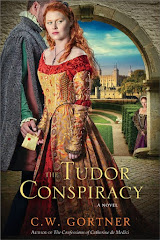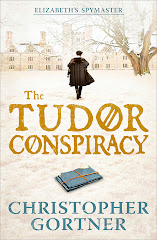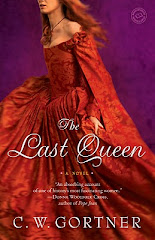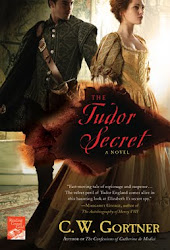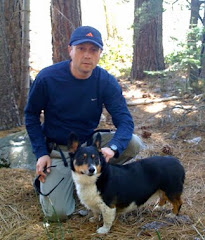Happy New Year!
Thanks for helping me launch this blog and for sticking around to read it. I've had a lot of fun with it. I started out with the personal mission that I wanted to feature writers whose books I've read and liked; to my surprise, some of the writers I ended up interviewing found me, instead. It's been an honor to feature their voices. Whether the writer is a woman or a man, published by a large commercial house or an independent, one thing stood out for me: historical fiction writers are some of the most dedicated and passionate people I know.
This also means I stuck to my 2007 resolution, which was to read more than I did in 2006. I managed to finish 34 books this year, 2 more than last year. Some books I reviewed for the Historical Novel Reviews; others, I read for this blog, and others for pure entertainment. I'm not including research books in my resolution, because I'm always doing research and I tend to read from an assortment of different books. While I usually finish almost all the non-fiction I tackle for research, it's done hapharzardly, as I careen from 16th century fashion accessories to buildings to family dynasties and politics, sometimes all within the same day.
Anyway, 2007 ended up being a terrific reading year for me, so I decided to compile my favorite 12 books for the year. This list doesn't include books featured on this blog; while they're also favorites, I wanted to highlight books I haven't mentioned. This list also isn't exclusive to books published in 2007. Hopefully, you'll find something new and exciting here. Also, please feel free to share any book you read in 2007 that kept you up at night, made you miss your bus stop, or consumed an entire afternoon of your life before you knew it. If you can, include a URL, too. As you may have noticed, I'm always on the look-out for new books to buy! And here's to reading more in 2008.
1) C.J. Samson, SOVEREIGNI'm a huge fan of the Matthew Shardlake mysteries, and in this third installment we're taken on progress to York, where Matthew must contend not only with the chaos of a royal progress but also the protection of a dangerous political prisoner. There are no anachronisms here: Shardlake's world is claustrophobic, treacherous and at times terribly cruel -- a Tudor England rarely depicted in fiction. Available in hardcover.
2) Patrick McGrath, MARTHA PEAKE

This haunting, gothic tale set during the American Revolution kept me up well into the night. Through the story of a young man facing an eerie legacy, we learn of the legendary Martha Peake, her eccentric, tormented father, and unexpected journey to the American colonies, where she finds herself immersed in the struggle for independence, both outwardly and in her spirit. Available in trade edition.
3) Judith Merkle Riley, THE WATER DEVIL
 The conclusion to her bestselling Margaret of Ashbury trilogy was first released in Germany, and it took more than fifteen years to be finally published here - but it was well worth the wait. With her trademark wit and sparkling prose, Ms Merkle Riley launches the resourceful Margaret and her family on a tumultuous, dysfunctional visit to her husband's familial manor, where supernatural events collide into human foibles, often with darkly humorous, spine-chilling results. Available in trade edition.
The conclusion to her bestselling Margaret of Ashbury trilogy was first released in Germany, and it took more than fifteen years to be finally published here - but it was well worth the wait. With her trademark wit and sparkling prose, Ms Merkle Riley launches the resourceful Margaret and her family on a tumultuous, dysfunctional visit to her husband's familial manor, where supernatural events collide into human foibles, often with darkly humorous, spine-chilling results. Available in trade edition.4) Michelle Lovric, THE FLOATING BOOK
The story of the first printer to set up shop in
 Venice is only one velvet layer in this evocative novel set in Venice in the 16th century; through the story of a vengeful woman, a poetic printer and the girl who loves him, Ms Lovric combines breathtaking lyricism with an ambitious storyline filled with delicate word gems. Available in hardcover and trade editions.
Venice is only one velvet layer in this evocative novel set in Venice in the 16th century; through the story of a vengeful woman, a poetic printer and the girl who loves him, Ms Lovric combines breathtaking lyricism with an ambitious storyline filled with delicate word gems. Available in hardcover and trade editions.5 - 8) Pauline Gedge, THE LORD OF THE TWO LANDS Trilogy
THE HIPPOTAMUS MARSH, THE OASIS, and THE HORUS ROAD are three novels that comprise Ms Gedge's epic reconstruction of the Egyptian princes' revol
 t against the invading Hyskos, which led to the founding of the 18th Dynasty, arguably the most famous of ancient Egypt. This is taut, compelling storytelling; while more military in theme than her other books, Gedge's uncanny ability to immersh you in the fascinating details of a vanished world without resorting to anachronisim is a wonder in of itself. The trilogy is best read in order. Available in hardcover and trade editions.
t against the invading Hyskos, which led to the founding of the 18th Dynasty, arguably the most famous of ancient Egypt. This is taut, compelling storytelling; while more military in theme than her other books, Gedge's uncanny ability to immersh you in the fascinating details of a vanished world without resorting to anachronisim is a wonder in of itself. The trilogy is best read in order. Available in hardcover and trade editions.7) Margaret Ball, DUCHESS OF AQUITAINE

Eleanor of Aquitaine is the Plantagenet poster girl and I'm not often drawn to books about her simply because I've read so many. Ms Ball's novel lanquished for years after it sold before her publisher decided to release it; who knows why it sat for so long, because Ball's take on a young, impetuous Eleanor who's a little pagan in her outlook on life is unexpectedly original. Combine it with a facility for description, and you've got a book worth reading, even if you think you know everything about this charismatic queen. Available in hardcover and trade editions.
8) Patricia Finney, GLORIANA'S TORCH

The conclusion to her trilogy featuring the tormented spymaster Becket and his posse of friends is as compulsively readable, and graphically accurate, as the previous two books. Here, Becket finds himself tracking a munitions plot that may lead to a Spanish attack on England, even as his friend Simon is captured as a spy by the Inquisition and chained to one of the Invincible Armada's galleys. The depiction of the Spanish point of view is rare, and the events surprise, even if the Armada's attack on England is an oft-told tale. Available in hardcover and trade editions.
9 - 12) Alice Borchardt, WOLF Trilogy

Alice Borchardt's death in 2007 was a loss to the historical / fantasy realm. I've had THE SILVER WOLF, NIGHT OF THE WOLF and THE WOLF KING in hardcover for years, but they got buried under subsequent purchases. When I finally unearthed them, I found Ms Borchardt's writing is lush and surprisingly unsentimental, and her tale of shapeshifters in Rome and France during the Dark Ages thrilled me without sacrificing historical detail. For me, these books strike that elusive balance between historical fiction, romance, and the supernatural. The trilogy is best read in order. Available in mass market paperback.








